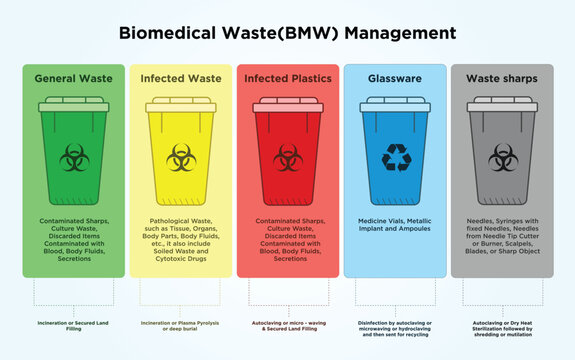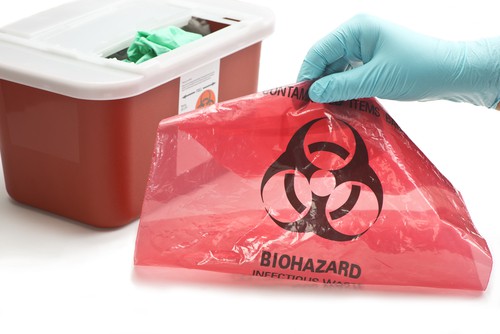Finest Practices for Medical Waste Monitoring
Clinical waste administration is a critical element of healthcare centers' procedures to ensure the safety and security of people, personnel, and the environment. Implementing ideal methods in medical waste monitoring is necessary to reduce the risks connected with dangerous waste.
Partition and Categorization
In the field of medical waste monitoring, proper partition and categorization are crucial methods for guaranteeing the secure and effective disposal of healthcare-related materials. Clinical waste is generated from numerous sources, consisting of healthcare facilities, clinics, research laboratories, and other medical care centers. It includes a large range of products, such as needles, syringes, plasters, handwear covers, and pharmaceutical waste.
Segregation includes the systematic separation of various kinds of medical waste based upon their characteristics and prospective threats. This process helps to avoid cross-contamination and makes certain that each kind of waste is managed suitably. For instance, sharps waste, such as blades and needles, should be placed in puncture-resistant containers to avoid injuries and the spread of transmittable illness. Similarly, contagious waste, such as blood-soaked bandages or cultures, ought to be segregated and treated separately to lessen the danger of spreading out virus.
Categorization is the process of categorizing medical waste into various groups based upon its prospective dangers. WasteX Medical Waste Disposal. These groups might consist of infectious waste, hazardous waste, pharmaceutical waste, and basic waste. By classifying waste, healthcare centers can figure out the proper disposal approaches and make certain compliance with local laws and guidelines
Proper partition and categorization of clinical waste not just shield the health and safety and security of health care workers and the basic public but additionally add to the overall performance and effectiveness of waste management. It lowers the danger of crashes, reduces ecological effects, and advertises accountable waste disposal methods.
Proper Storage and Classifying
To guarantee the reliable and safe disposal of clinical waste, healthcare facilities have to stick to correct storage and labeling methods. Proper storage space and labeling play a crucial role in keeping the integrity of medical waste monitoring systems and protecting the health and wellness and safety of health care employees, patients, and the general public.
When it involves storage, it is vital to have assigned locations especially designed for different kinds of clinical waste. These locations should be protected, well-ventilated, and furnished with ideal containers that satisfy regulatory requirements. Segregation and classification of waste need to additionally be considered to avoid cross-contamination and potential risks.
Additionally, proper labeling is important for effective waste administration - medical waste disposal service. Each container must be clearly labeled with the appropriate symbols, color-coding, and details regarding the waste it consists of.
Routine monitoring and inspection of storage space areas and containers are necessary to determine any concerns or infractions. Personnel should be educated on appropriate storage and labeling techniques, stressing the value of compliance with procedures and regulations.
Safe Transport and Handling
Making sure the appropriate and secure transport and handling of medical waste is essential for keeping the stability of waste management systems and securing the health and safety and security of all included. Clinical waste, that includes things polluted with transmittable materials, drugs, and other harmful substances, need to be transferred in a fashion that avoids leakages, spills, and prospective contamination.
It is essential to utilize watertight and puncture-resistant containers that are especially designed for medical waste. In addition, waste needs to be segregated based on its nature and type to avoid cross-contamination.
Throughout transport, it is very important to ensure top article that waste containers are securely fastened and stored in a steady manner. Automobiles utilized for delivering clinical waste needs to be outfitted with ideal safety features, such as spill control systems, to decrease the threat of any kind of spills or leakages (medical waste removal service). Drivers should obtain training on correct handling and emergency situation feedback treatments to efficiently attend to any type of unexpected incidents
Furthermore, the transport and handling of clinical waste must follow all appropriate regulations and standards set forth by regional, state, and federal authorities. Normal assessments and audits ought to be conducted to analyze conformity and determine any locations for enhancement.

Conformity With Regulatory Guidelines
Maintaining conformity with regulatory standards is necessary for efficient medical waste administration. These guidelines are established to safeguard public wellness and the atmosphere by guaranteeing that clinical waste is appropriately dealt with, dealt with, and disposed of. medical waste disposal service. Compliance with governing guidelines aids to avoid the spread of transmittable illness, minimize prospective hazards, and minimize the overall effect of medical waste on the atmosphere
To accomplish conformity, health care facilities need to stay educated about the details policies controling medical waste administration in their jurisdiction. These guidelines might differ from nation to country, and even within different states or areas. It is necessary for healthcare facilities to have a thorough understanding of these guidelines and to carry out appropriate methods and methods to ensure compliance.
One trick facet of conformity is the appropriate partition and labeling of various kinds of medical waste. This includes separating sharps from various other waste, along with categorizing waste based on its prospective dangers. Medical care centers have to likewise ensure that medical waste is kept in ideal containers which these containers are correctly identified and secured.
In addition, conformity with governing guidelines requires healthcare facilities to establish proper training and education programs for personnel included in medical waste administration - WasteX Medical Waste Disposal. This consists of supplying training on waste partition, managing, and disposal treatments, in addition to the appropriate use personal protective tools
Normal tracking and audits are likewise vital to guarantee ongoing compliance with governing standards. This involves conducting normal examinations of waste storage space areas, recording waste monitoring procedures, and maintaining documents of waste disposal.
Effective Disposal Approaches
Health care facilities have to utilize effective disposal approaches for appropriate management of clinical waste - WasteX Medical Waste Disposal. Incorrect disposal of medical waste can pose severe wellness and environmental threats. There are a number of approaches that can be utilized to properly take care of medical waste, making certain the safety of medical care workers, individuals, and the basic public
One generally used approach is incineration. Incinerators can safely melt medical waste at high temperature levels, reducing the volume and ruining any kind of potentially dangerous pathogens. Incineration can be expensive and might launch harmful contaminants right into the air if not effectively regulated.
Another technique is autoclaving, which entails subjecting the waste to high-pressure steam. This process eliminates bacteria, viruses, and various other microorganisms, making the waste secure for disposal in regular waste streams. Autoclaving is a efficient and environmentally pleasant approach, yet it requires specific tools and trained workers.
Chemical sanitation is additionally used sometimes, where liquid chemicals are put on the waste to disinfect it. This method is less frequently made use of as a result of concerns about the efficiency of chemical sanitation and the possibility for chemical residues to pollute the setting.
Along with these methods, healthcare facilities ought to likewise carry out appropriate partition, product packaging, and labeling of clinical waste to ensure its risk-free handling and disposal. Normal training and education and learning of personnel on correct waste monitoring practices are vital to keeping reliable disposal approaches.
Verdict

Medical waste monitoring is a critical facet of health care centers' operations to ensure the security of patients, team, and the environment. Applying finest techniques in medical waste monitoring is vital to minimize the dangers associated with harmful waste. These categories may consist of contagious waste, unsafe waste, pharmaceutical waste, and general waste.In verdict, implementing finest techniques for medical waste monitoring is essential for making sure the safety of healthcare employees, patients, and the atmosphere. By effectively classifying and setting apart waste, storing and identifying it appropriately, ensuring risk-free transport and handling, abiding with regulatory standards, and employing efficient disposal approaches, healthcare facilities can successfully take care of and minimize the risks connected with clinical waste.